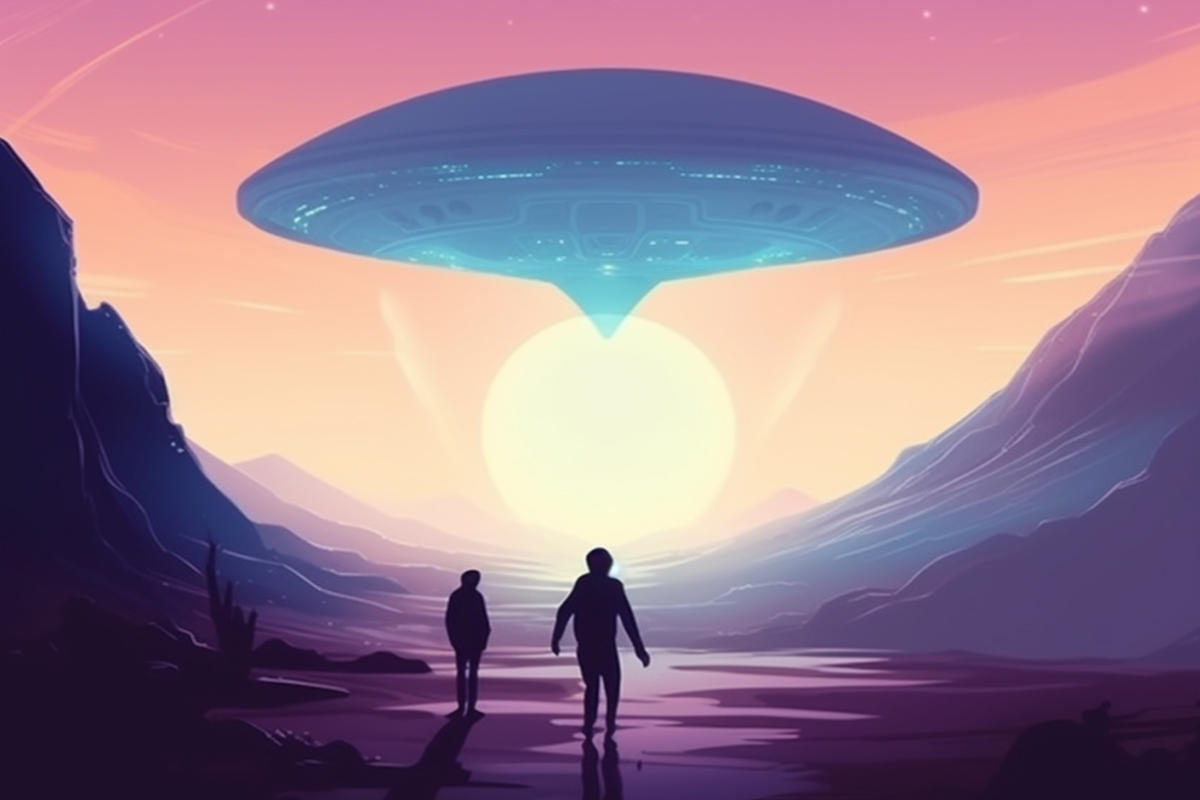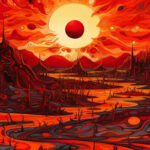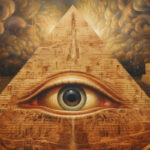First contact books have long fascinated readers with their imaginative and thought-provoking takes on alien encounters and humanity’s response to meeting extraterrestrial life. From the classics to modern masterpieces and hidden gems, there is certainly no shortage of captivating stories in this genre.
In this article, we will explore ten of the best first contact books that deserve a spot on your reading list. These novels will undoubtedly provide a thrilling and thought-provoking reading experience, allowing you to explore the infinite possibilities of the universe and the mysteries of extraterrestrial life.

Why First Contact Books are So Captivating
The allure of first contact books stems from several elements, including the intrigue of alien encounters, exploration of humanity’s reaction to the unknown, and the evolution of the first contact story over time.
The Intrigue of Alien Encounters
One of the main reasons why first contact books continue to captivate readers is the inherent intrigue in imagining encounters with intelligent, extraterrestrial life forms. These stories often present interesting hypothetical scenarios, allowing us to ponder questions such as: What would aliens look like? How would they communicate? What motivations might they have for visiting Earth or making contact with humanity?
As readers dive into these mysteries, they are transported into a world where the unexpected can and often does happen, making first contact books an exciting and unpredictable journey.
For example, in the classic science fiction novel “Contact” by Carl Sagan, readers are taken on a journey with protagonist Ellie Arroway as she discovers a message from extraterrestrial life and embarks on a journey to make contact. Along the way, she faces challenges and obstacles that force her to confront her own beliefs and the beliefs of those around her.
Exploring Humanity’s Reaction to the Unknown
Another compelling aspect of first contact books is the exploration of humanity’s response to the possibility of extraterrestrial life, both on a personal and societal level. These narratives often delve into the psychology of fear, curiosity, and hope, revealing the multifaceted emotions that we may experience when faced with the unknown.
For instance, in the novel “The War of the Worlds” by H.G. Wells, readers witness the panic and chaos that ensues when Martians invade Earth. Through the eyes of the protagonist, readers experience the fear and confusion that comes with the realization that humanity is not alone in the universe.
From the government’s attempts at diplomacy to the reactions of everyday people, first contact books provide an insightful look into the complexities of human behavior and the myriad of ways in which we might handle the revelation of a previously unknown form of intelligent life.
The Evolution of First Contact Stories
Over the years, the genre of first contact books has evolved significantly. As science and technology rapidly advance, authors have been able to incorporate new discoveries and theories into their works, resulting in increasingly creative and scientifically-grounded stories.
For example, in the novel “The Three-Body Problem” by Liu Cixin, the author incorporates the concept of the three-body problem in physics to create a unique and thought-provoking story about humanity’s first contact with an alien civilization.
From the early days of H.G. Wells to the wildly imaginative works of Arthur C. Clarke, Carl Sagan, and modern authors like Liu Cixin, the first contact genre has seen numerous transformations while maintaining a loyal and passionately engaged readership.
Overall, first contact sci-fi books offer readers a thrilling and thought-provoking journey into the unknown, exploring the depths of human emotion and imagination while pushing the boundaries of what we know about the universe.
The Classics: Timeless First Contact Novels
First contact novels have always been a popular genre among science fiction enthusiasts. They offer a unique perspective on what it would be like to encounter intelligent life from beyond our planet. While many first contact novels have been written over the years, there are several that have stood the test of time, proving their enduring appeal and their status as true classics of the genre.
The War of the Worlds by H.G. Wells
One of the earliest works in the first contact genre, H.G. Wells’ The War of the Worlds (1898) is a foundational novel that continues to captivate readers today. The story follows a Martian invasion of Earth and the human struggle against the technologically superior extraterrestrial invaders. Despite its age, The War of the Worlds remains a thrilling and relevant novel that has inspired countless adaptations and has laid the groundwork for many future first contact narratives.
The novel is set in Victorian England, a time when the British Empire was at its height. The invasion of Earth by the Martians was a metaphor for the fear and anxiety that the British people felt about the possibility of being invaded by a foreign power. The novel explores themes of imperialism, colonialism, and the struggle for survival against overwhelming odds. It is a testament to Wells’ skill as a writer that the novel remains as powerful and relevant today as it did over a century ago.
Childhood’s End by Arthur C. Clarke
Childhood’s End (1953) by Arthur C. Clarke tells the story of a benevolent alien race, the Overlords, who come to Earth and establish a seemingly utopian society. However, beneath the surface of this harmonious world lies a darker truth about humanity’s true purpose and destiny. This thought-provoking novel remains an essential read for first contact enthusiasts and offers a unique and insightful look at humanity’s future.
The novel explores the idea of a utopian society and the price that must be paid for such a society to exist. The Overlords are portrayed as benevolent beings who have the best interests of humanity at heart. However, as the story progresses, it becomes clear that their true motives are not as altruistic as they first appear. The novel raises questions about the nature of power, the role of technology in society, and the ultimate fate of humanity.
Contact by Carl Sagan
In Contact (1985), the late astrophysicist and author Carl Sagan delivers a scientifically-grounded and deeply philosophical story about humanity’s first encounter with extraterrestrial intelligence. The novel follows Ellie Arroway, a radio astronomer who discovers a signal from deep space that appears to be a blueprint for a complex machine. As a group of international scientists work together to decipher the message and build the machine, they are faced with profound questions about the nature of our existence and the possibilities of the universe.
The novel is a testament to Sagan’s scientific knowledge and his ability to communicate complex ideas in a way that is accessible to a general audience. The story explores the idea of the universe as a vast and mysterious place, filled with wonders and dangers that we can only begin to imagine. It raises questions about the nature of consciousness, the limits of our knowledge, and the role that science and technology play in shaping our understanding of the world around us.
Modern Masterpieces: First Contact Books from the 21st Century
In recent years, the genre of first contact books has continued to flourish, with numerous modern masterpieces offering fresh and inventive takes on the classic theme.
First contact stories have always been a staple of science fiction. They explore what might happen if humanity were to encounter an alien race for the first time. These stories can be full of wonder, excitement, and danger. They can also be thought-provoking, raising questions about what it means to be human and the nature of consciousness, perception, and intelligence.
The Three-Body Problem by Liu Cixin
Chinese author Liu Cixin’s The Three-Body Problem (2008), translated by Ken Liu, presents a unique and expansive exploration of first contact. Focused on a physicist who receives a mysterious message from a distant star system, the novel takes readers on an exhilarating journey filled with intrigue, adventure, and thought-provoking scientific concepts.
The novel’s title refers to a problem in physics that deals with predicting the movements of three celestial bodies. The concept is used as a metaphor for the complex interactions between humans and aliens in the novel. As the story unfolds, readers are introduced to a fascinating and intricate alien civilization, with its own history, politics, and culture.
The Three-Body Problem is the first in a trilogy and is a must-read for fans of the first contact genre. It won the Hugo Award for Best Novel in 2015, making Liu Cixin the first Asian author to win the award.
Blindsight by Peter Watts
Blindsight (2006) by Peter Watts is a dark, thought-provoking, and philosophically rich tale of first contact. The story follows a team of astronauts and scientists sent to investigate an alien vessel on the edge of our solar system.
The aliens in Blindsight are truly alien, with a biology and consciousness that is vastly different from our own. Watts explores the implications of this, asking whether we can ever truly understand something so fundamentally different from ourselves.
The novel is also notable for its exploration of transhumanism and posthumanism. The characters in the story have undergone various forms of genetic and cybernetic enhancement, blurring the line between human and machine.
Overall, Blindsight is a challenging and rewarding read for fans of hard science fiction and first contact stories.
Ancillary Justice by Ann Leckie
Ancillary Justice (2013) by Ann Leckie is the first novel in the critically acclaimed Imperial Radch trilogy. This space opera combines elements of first contact with artificial intelligence, as it follows Breq, a sentient starship and former soldier, seeking revenge against those who destroyed her.
The novel is notable for its exploration of gender and identity. In the Radch Empire, gender is not a concept that exists, and all citizens are referred to with female pronouns. This leads to interesting questions about how we perceive gender and the role it plays in our own society.
As Breq encounters unfamiliar humanoid species and navigates complex webs of politics and intrigue, the novel raises profound questions about identity, consciousness, and what it means to be human. It won the Hugo, Nebula, and Arthur C. Clarke awards, making it one of the most decorated science fiction novels of all time.
Hidden Gems: Lesser-Known First Contact Books Worth Reading
Aside from the well-known classics and modern masterpieces, there are numerous lesser-known first contact novels that are truly worth discovering.
A Darkling Sea by James L. Cambias
A Darkling Sea (2014) by James L. Cambias is a highly engaging first contact novel that explores the politics and challenges of dealing with multiple alien species. Set on a distant ice-covered planet, the story focuses on the interactions between humans, an aquatic alien species called the Ilmatarans, and a third party of spacefaring aliens, the Sholen. This under-the-radar gem is perfect for fans of both first contact and planetary exploration stories.
The Sparrow by Mary Doria Russell
The Sparrow (1996) by Mary Doria Russell is an emotional and profound first contact tale that combines elements of science fiction, religion, and philosophy. In this story, a group of Jesuit priests and scientists are the first to journey to a distant planet to make contact with its inhabitants. As their mission unfolds, the implications of first contact lead to profound spiritual and philosophical questions, resulting in a deeply moving and memorable narrative.
Learning the World by Ken MacLeod
In Learning the World (2005) by Ken MacLeod, two populations – a group of human settlers traveling on a generation ship, and the sentient winged beings native to their destination planet – face the challenges and revelations that come with first contact. Told from multiple perspectives, this novel takes a fresh approach to the genre while maintaining the sense of wonder and depth that makes first contact stories so engaging.
In conclusion, the ten novels listed above represent some of the finest first contact literature and are sure to thrill, captivate, and make you think. Satisfy your hunger for the unknown with these masterful works of speculative fiction, and you’ll be enthralled by what’s waiting beyond the stars.
FAQs
What genre does first contact belong to?
The first contact subgenre is an example of science fiction writing.
What are some of the best first contact books?
Semiosis by Sue Burke, Tomorrow’s Kin by Nancy Kress, Dawn by Octavia Butler, Wherever Seeds May Fall by Peter Cawdron, and Rendezvous with Rama by Arthur C. Clarke are all good first contact books.
Who is the best first-contact novelist?
Peter Cawdron has written over 20 books that fit within this subgenre. His work is highly gripping, innovative, and accessible to all readers.
- The 11 Best Books About Cats You Should Read - January 16, 2024
- The 9 Best Books on Building Confidence - January 16, 2024
- Discover the 10 Best Books on the Brain - January 16, 2024

